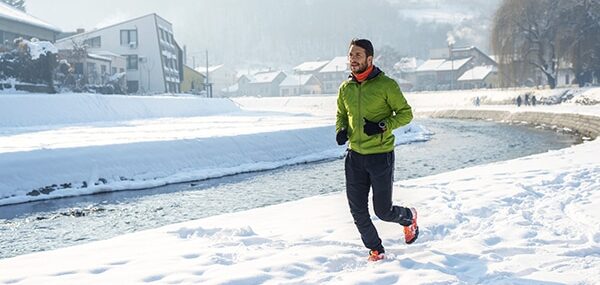
When the thermostat descends and the days grow shorter and darker, it’s tempting to want to peek back under the covers and hibernate. But maintaining an exercise routine throughout the winter offers tangible health benefits.
You burn more calories.
As the body works harder to regulate its core temperature among the elements, you’ll burn a few more calories during your wintry workout compared to one conducted indoors. While the calorie burn varies with each person’s body mass and the extremity of the temperature, it can be a nice morale booster (especially around the food-focused holidays) to get more out of your workout.
Your endurance performance increases.
Whether you like to walk, run, or bike, the heat and humidity of summer can make it pretty difficult to up your intensity or mileage. Winter, on the other hand, makes it a lot easier to handle since you aren’t subject to the same stresses. And don’t think you can get away with the old excuse that the cold air is bad for your lungs because it just isn’t true. By challenging yourself in the cold weather, you are strengthening your heart, lungs and circulatory system, thereby improving your overall health. However, if you have asthma or another lung disease please check in with your health care provider before embarking on an outdoor adventure.
You’ll feel happier and more energized.
Working out in the winter can help fight SAD (Seasonal affective disorder). Seasonal affective disorder can affect as many as 20 percent of Americans who find themselves with severe to mild depression during the cold months. One of the best ways to combat this blah feeling it to get moving.
Cold-weather exercise has the ability to boost one’s mood, thanks to the lack of humidity (which creates that heavy air feeling in the summer months) and the cold stimulates your parasympathetic system. The sympathetic system is known as the “fight or flight” response while the parasympathetic is known as the “relax and renew” system. These endorphins can trigger the release of dopamine and serotonin, neurotransmitters that will leave you with a stronger sense of happiness and lightness following a workout in the cold.
You’ll strengthen your heart.
Cold weather also makes the heart work harder to distribute blood throughout the body. But a regular exerciser with cardiovascular endurance can make their heart muscle even stronger with these cold-weather sessions, better preparing the body for more strenuous workouts in the future — not to mention other non-exercise stresses in life.
You’ll get a dose of vitamin D.
Being outside and taking in more sun during the daylight hours helps keep your mind sharp as well as increasing your body’s manufacturing of vitamin D. The relative benefit also feels more substantial in the wintertime since the amount of natural light is already so restricted.
You’ll boost your immune system.
Every winter brings a new round of nasty sick spells, which most people blame on the cold weather. It’s a common misconception that being in the cold can give you a cold, but it’s not true. In fact, exercise is one of the best ways to strengthen your immune system. Staying cooped up inside may actually expose you to more people who may be harboring this season’s latest cold, so getting away from all those folks may actually reduce your chances of catching the same bug.
You’ll maintain your fitness.
Those with gym memberships struggle to use them as much as they intend when the weather’s pleasant, so they’re unlikely to do much better once a trip there means venturing into the cold. A short break can easily stretch into a prolonged one. This period of detraining can lead to aerobic loss in just a few weeks, and muscular strength begins to diminish after about four weeks as well. Maintain your routine this winter, and spring workouts will be a lot less of a chore.
Exercisers are often concerned about the internal safety hazards that come along with chilly sweat sessions, but there is surprisingly little to worry about. Simply suiting up appropriately with enough layers made of moisture-wicking fabrics keeps the body at a healthy temperature and functioning the same way it would in any other workout environment.
Keep it safe, a few simple tips for exercising in the cold:
- Make sure you hydrate before, during and after your workout.
- Wear layers that you can peel off as necessary.
- Wear a hat and gloves.
- Adequately insulate your extremities. The face, fingers and toes are the first to get frostbitten. (Pain or tingling in your ears, fingers or toes is usually a sign it’s time to come indoors and warm up.)
- Beware of ice.
No excuses now! Don’t let the cold keep you indoors this winter. Get outside, get your butt moving and enjoy the extra benefits a cold weather workout has to offer.









